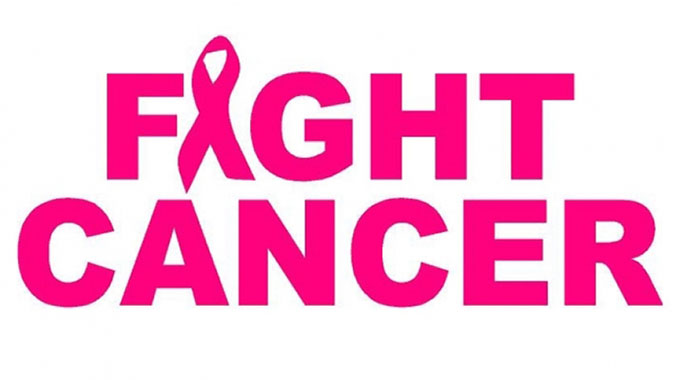Cancer cases rise steadily

Sifelani Tsiko Senior Writer
At least 7 265 Zimbabweans were diagnosed with cancer in 2016, an increase of about 100 above the 2015 figures (7 165).
The latest figures published by the Zimbabwe National Cancer Registry are based on diagnoses reported to the cancer registry offices in Harare and Bulawayo, both public and private hospitals, health laboratories, haematology and radiology reports.
The registry said there were no significant observations made in the results for 2016 when compared with those made in recent years.
“The incidence and pattern of cancer occurrence, particularly the rankings of the common malignancies by gender and ethnicity remained relatively unchanged. Consistent with observations made in recent years, the incidence of prostate cancer continues to rise unchallenged,” said ZNCR registrar Mr Eric Chokunonga.
It is for the first time that the cancer registry has expanded its sources of information as it steps up efforts to speed up data collection to help the country to respond to complex health and development issues.
It’s also worthwhile to note that Zimbabwe has one of the oldest cancer registries on the continent, which has been relied upon extensively to support the setting up of cancer registry offices in various parts of Africa.
The latest data suggest that the number of cancer diagnoses has risen significantly from 4 015 in 2005 to 7 265 in 2016.
The rise in cancer cases in Zimbabwe is largely due to changes in diet and rapid urbanisation.
Cancer experts say as the country was rapidly urbanising, more people are getting cancers related to lifestyle rather than those linked to poverty.
The latest Zimbabwe National Cancer Registry report reveals that the total number of new cancer cases recorded among Zimbabweans of all races in 2016 was 7 265 comprising 3 123 (43.0 percent) males and 4 142 (57.0 percent) females.
In Harare, a total of 2 558 (35,2 percent) malignant tumours consisting of 1 181 males (46,2 percent) and 1 377 (53,8 percent) females were registered while the number of new registrations in Bulawayo was 1 111 (15,3 percent), comprising 493 (44,4 percent) men and 618 (55,6 percent) women.
Cervical cancer remained the lead cancer followed by prostate, breast cancer, Kaposi sarcoma, non-Hodgkin lymphoma, non-melanoma skin cancer, oesophagus and colorectal in that order.
The most frequently occurring cancers among Zimbabweans of all races in 2016 were cervix uteri (18 percent), prostate (10 percent), breast (eight percent), Kaposi sarcoma (KS) (six percent), non-Hodgkin lymphoma (NHL) (five percent), oesophagus (five percent), non-melanoma skin cancer (NMSC) (five percent), colorectal (four percent) and stomach (four percent). The other cancers accounted for 35 percent of the registered malignancies.
The leading causes of cancer among Zimbabwean black men in 2016 were prostate cancer (22,8 percent), followed by KS (10,4 percent), NHL (8,1 percent), oesophagus (7,2 percent), liver (five percent), stomach (3,9 percent), eye (3,3 percent), lung (3,2 percent), NMSC (2,8 percent) and colon (2,7 percent).
In Zimbabwe black women, the most common cancers were cervical cancer (33,2 percent), breast (12,1 percent), oesophagus (4,6 percent), KS (4,1 percent), NHL (3,8 percent), stomach (3,6 percent), ovary (2,9 percent), liver (2,7 percent), colon (2,3 percent) and tumours of the brain and nervous system (2,2 percent).
Non-melanoma skin cancer (NMSC) was the most frequent cancer among Zimbabwean non-black men (42 percent) in 2016.
This was followed by prostate cancer (14,8 percent), lung (6,2 percent), melanoma skin cancer (MSC) (6,2 percent), colon (4,7 percent), rectum (3,9 percent), bladder (3,1 percent), NHL (2,7 percent), oesophagus (1,6 percent) and breast (1,6 percent).
The leading cancers in non-black Zimbabwean women were NMSC (40,1 percent), breast (23 percent), lung (6,3 percent), melanoma skin cancer (MSC) (5 percent), NHL (3,6 percent), colon (3,2 percent), rectum (2,7 percent), corpus uteri (2,7 percent), cervix uteri (2,3 percent) and ovary (1,4 percent).
A total of 268 childhood cancers (age 0-14) of all races were recorded in 2016. These comprised 154 (57,5 percent) boys and 114 (42,5 percent) girls. The cancers accounted for 3,7 percent of all the cancers recorded in 2016.
The leading causes of cancer deaths among children included leukaemia, lymphoma, tumours of the brain, renal tumours, nervous system, eye, soft tissue tumours and bone tumours.
The most common childhood cancers of all races recorded in 2016 according to the International Classification of Childhood Cancer (ICCC) were as follows: renal tumours (19 percent), leukaemia (15 percent), soft tissue and other extra-osseous sarcomas (13 percent), lymphomas and reticuloendothelial neoplasms (13 percent), retinoblastomas (11 percent), central nervous system and miscellaneous intracranial and intraspinal neoplasms (11 percent), malignant bone tumours (six percent) and hepatic tumours (three percent).
Kaposi sarcoma accounted for 22,2 percent of the soft tissue and other extra-osseous sarcomas in both boys and girls.
A total of 2 751 cancer deaths comprising 1 286 (46,7 percent) males and 1 465 (53,3 percent) females were recorded in Harare, Chitungwiza and Bulawayo in 2016. The leading causes of the deaths were cervical cancer (12 percent), prostate (11 percent), oesophagus (eight percent), breast (seven percent), liver (six percent), non-Hodgkin lymphoma (five percent), stomach (five percent), colorectal (four percent) and Kaposi sarcoma (four percent). The other cancers constituted 38 percent of the recorded deaths.
A total of 126 childhood cancer deaths were recorded in 2016. These consisted of 74 (58,7 percent) boys and 52 (41,3 percent) girls. The leading causes of mortality among the children were as follows: leukaemia (20 percent), renal tumours (16 percent), lymphoma (15 percent), tumours of the brain and nervous system (11 percent), retinoblastoma (10 percent). The other cancers constituted 28 percent of the deaths.
ZNCR registrar, Mr Chokunonga said the year 2016 represented the most completely documented in the history of the country.
“In 2018, serious efforts were made to improve national coverage by conducting a national outreach programme to collect clinically diagnosed cases in the provinces that may not have been referred to facilities in Harare and Bulawayo,” he said.
“This was done to ensure that the data for this report for 2016 would be as complete as practically possible.”
However, despite the great strides made ZNCR, the report indicated that little progress had been made to enact the necessary legislation to make cancer a notifiable disease by 2018.
This was largely due to lack of resources and lack of a lobby for the amendment of the Public Health Act to make cancer a reportable disease. It is also worrying that there was no budgetary support in 2016 to fund the extension of ZNCR activities to the provinces.
Zimbabwe has made noteworthy progress in the conduct periodic health programme reviews to establish whether policies are producing the desired results.
It has undertaken assessments on the incidence, distribution, and control of diseases. This is done through frequent analysis of routinely collected data with the aim of improving programme implementation.
These periodic reviews have served as an important input for national strategic plans. But, critics observe that there are still challenges with the collection of accurate and timely data, their utility, use and analytical capacity.
This means that it will continue to be difficult for Zimbabwe to develop evidence-based policies.
Data experts who may include data managers, statisticians and data analysts need to be supported with resources to help them generate data that can help Zimbabwe to meet its national and regional commitments to sustainable development goals on health.
The Government must invest reasonably to help generate data that is relevant, timely and accurate for decision-making purposes.
This is critical to improving the effectiveness and sustainability of our health systems.







Comments